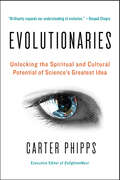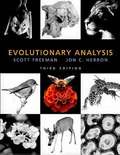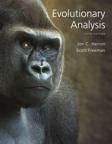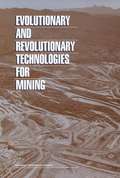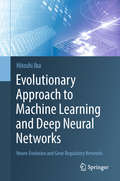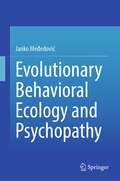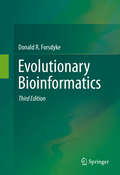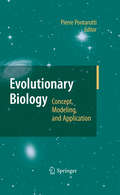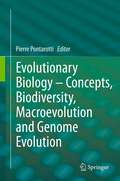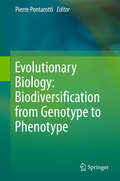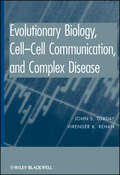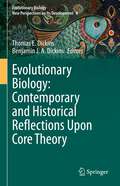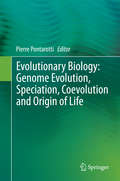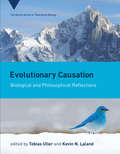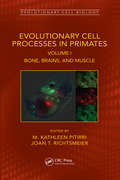- Table View
- List View
Evolutionaries: Unlocking the Spiritual and Cultural Potential of Science's Greatest Idea
by Carter PhippsThis survey of science, religion and philosophy by an Integral thought leader “brilliantly expands our understanding of evolution” (Deepak Chopra).Blending cutting-edge ideas with spiritual insights, Evolutionaries is the first popular presentation of an emerging school of thought called “evolutionary spirituality.” Carter Phipps, the former executive editor of EnlightenNext magazine, asserts that evolution is not only a scientific but also a spiritual idea in a book whose message has the power to bring new meaning and purpose to life as we know it. Readers will be fascinated and enlightened by Evolutionaries, a book which Deepak Chopra says “is going to help create a worldview that will influence our vision of the future direction of evolution and also our role in consciously participating in it.”“A profound and profoundly important new work.” —Ken Wilber, author of A Brief History of Everything and The Integral Vision “No one has their head and heart around the full range of evolutionary worldviews like Carter Phipps.” —Reverend Michael Dowd, author of Thank God for Evolution “A significant contribution.” John F. Haught, Senior Fellow at Georgetown University's Woodstock Theological Center and Former Chair and Professor of the Department of Theology at Georgetown University“It would be hard to find a better guide into this fascinating conversation than Carter Phipps’s Evolutionaries.” —Brian Swimme, Ph.D, Director of the Center for the Story of the Universe and Professor at the California Institute of Integral Studies “Thoughtful and provocative.” —Kirkus Reviews“Phipps’s writing projects a palpable sense of positivity and excitement for what is to come.” —Publishers Weekly
Evolutionary Analysis
by Scott Freeman John C. HerronThe third edition of Evolutionary Analysis is for undergraduates majoring in the life sciences. Text contains clearly described figures and there are mathematical formulae.
Evolutionary Analysis (5th Edition)
by Scott Freeman Jon C. HerronBy presenting evolutionary biology as a dynamic, ongoing research effort and organizing discussions around questions, this best-selling text helps you think like a scientist as you learn about evolution. The authors convey the excitement and logic of evolutionary science by introducing principles through recent and classical studies, and by emphasizing real-world applications.
Evolutionary And Revolutionary Technologies For Mining
by Committee on Technologies for the Mining IndustriesThe report identifies research areas for new technologies that would address exploration; mining and processing; and associated health and safety, and environmental issues. It also calls for enhanced cooperation between government, industry, and academia in mineral research and development. Annotation (c)2003 Book News, Inc. , Portland, OR (booknews. com)
Evolutionary Approach to Machine Learning and Deep Neural Networks: Neuro-Evolution and Gene Regulatory Networks
by Hitoshi IbaThis book provides theoretical and practical knowledge about a methodology for evolutionary algorithm-based search strategy with the integration of several machine learning and deep learning techniques. These include convolutional neural networks, Gröbner bases, relevance vector machines, transfer learning, bagging and boosting methods, clustering techniques (affinity propagation), and belief networks, among others. The development of such tools contributes to better optimizing methodologies. Beginning with the essentials of evolutionary algorithms and covering interdisciplinary research topics, the contents of this book are valuable for different classes of readers: novice, intermediate, and also expert readers from related fields.Following the chapters on introduction and basic methods, Chapter 3 details a new research direction, i.e., neuro-evolution, an evolutionary method for the generation of deep neural networks, and also describes how evolutionary methods are extended in combination with machine learning techniques. Chapter 4 includes novel methods such as particle swarm optimization based on affinity propagation (PSOAP), and transfer learning for differential evolution (TRADE), another machine learning approach for extending differential evolution. The last chapter is dedicated to the state of the art in gene regulatory network (GRN) research as one of the most interesting and active research fields. The author describes an evolving reaction network, which expands the neuro-evolution methodology to produce a type of genetic network suitable for biochemical systems and has succeeded in designing genetic circuits in synthetic biology. The author also presents real-world GRN application to several artificial intelligent tasks, proposing a framework of motion generation by GRNs (MONGERN), which evolves GRNs to operate a real humanoid robot.
Evolutionary Behavioral Ecology and Psychopathy
by Janko MeđedovićThis book examines the study of psychopathy using behavioral ecological framework. It consists of two parts. The first describes the science of human behavioral ecology, including:• Basic concepts of evolutionary biology• Evolutionary behavioral sciences• Evolutionary ecology of family• Evolutionary tradeoffs• Life history theory• Behavioral ecology of personality• Psychopathy and its current evolution.The second part of the book describes empirical research on psychopathy in evolutionary ecological context, aiming to explore fertility-longevity tradeoffs in psychopathy, interacting phenotypes in psychopathy, and parental effects associated with psychopathy. This part contains the discussion of the study’s findings which is based on several theoretical concepts described in part one. This volume is ideal for psychopathy researchers hoping to bridge the natural and social sciences in a new and innovative way.
Evolutionary Biogeography: An Integrative Approach with Case Studies
by Juan J. MorroneRather than favoring only one approach, Juan J. Morrone proposes a comprehensive treatment of the developments and theories of evolutionary biogeography. Evolutionary biogeography uses distributional, phylogenetic, molecular, and fossil data to assess the historical changes that have produced current biotic patterns. Panbiogeography, parsimony analysis of endemicity, cladistic biogeography, and phylogeography are the four recent and most common approaches. Many conceive of these methods as representing different "schools," but Morrone shows how each addresses different questions in the various steps of an evolutionary biogeographical analysis. Panbiogeography and parsimony analysis of endemicity are useful for identifying biotic components or areas of endemism. Cladistic biogeography uses phylogenetic data to determine the relationships between these biotic components. Further information on fossils, phylogeographic patterns, and molecular clocks can be incorporated to identify different cenocrons. Finally, available geological knowledge can help construct a geobiotic scenario that may explain how analyzed areas were put into contact and how the biotic components and cenocrons inhabiting them evolved. Morrone compares these methods and employs case studies to make it clear which is best for the question at hand. Set problems, discussion sections, and glossaries further enhance classroom use.
Evolutionary Biogeography: An Integrative Approach with Case Studies (Crc Biogeography Ser.)
by Juan MorroneRather than favoring only one approach, Juan J. Morrone proposes a comprehensive treatment of the developments and theories of evolutionary biogeography. Evolutionary biogeography uses distributional, phylogenetic, molecular, and fossil data to assess the historical changes that have produced current biotic patterns. Panbiogeography, parsimony analysis of endemicity, cladistic biogeography, and phylogeography are the four recent and most common approaches. Many conceive of these methods as representing different "schools," but Morrone shows how each addresses different questions in the various steps of an evolutionary biogeographical analysis. Panbiogeography and parsimony analysis of endemicity are useful for identifying biotic components or areas of endemism. Cladistic biogeography uses phylogenetic data to determine the relationships between these biotic components. Further information on fossils, phylogeographic patterns, and molecular clocks can be incorporated to identify different cenocrons. Finally, available geological knowledge can help construct a geobiotic scenario that may explain how analyzed areas were put into contact and how the biotic components and cenocrons inhabiting them evolved. Morrone compares these methods and employs case studies to make it clear which is best for the question at hand. Set problems, discussion sections, and glossaries further enhance classroom use.
Evolutionary Bioinformatics
by Donald R. ForsdykeNow in its third edition and supplemented with more online material, this book aims to make the "new" information-based (rather than gene-based) bioinformatics intelligible both to the "bio" people and the "info" people. Books on bioinformatics have traditionally served gene-hunters, and biologists who wish to construct family trees showing tidy lines of descent. While dealing extensively with the exciting topics of gene discovery and database-searching, such books have hardly considered genomes as information channels through which multiple forms and levels of information have passed through the generations. This "new bioinformatics" contrasts with the "old" gene-based bioinformatics that so preoccupies previous texts. Forms of information that we are familiar with (mental, textual) are related to forms with which we are less familiar (hereditary). The book extends a line of evolutionary thought that leads from the nineteenth century (Darwin, Butler, Romanes, Bateson), through the twentieth (Goldschmidt, White), and into the twenty first (the final works of the late Stephen Jay Gould). Long an area of controversy, diverging views may now be reconciled.
Evolutionary Biology
by R. Paul Thompson Denis WalshEvolution - both the fact that it occurred and the theory describing the mechanisms by which it occurred - is an intrinsic and central component in modern biology. Theodosius Dobzhansky captures this well in the much-quoted title of his 1973 paper 'Nothing in biology makes sense except in the light of evolution'. The correctness of this assertion is even more obvious today: philosophers of biology and biologists agree that the fact of evolution is undeniable and that the theory of evolution explains that fact. Such a theory has far-reaching implications. In this volume, eleven distinguished scholars address the conceptual, metaphysical and epistemological richness of the theory and its ethical and religious impact, exploring topics including DNA barcoding, three grand challenges of human evolution, functionalism, historicity, design, evolution and development, and religion and secular humanism. The volume will be of great interest to those studying philosophy of biology and evolutionary biology.
Evolutionary Biology
by Pierre PontarottiSince 1997, scientists of different disciplines sharing a deep interest in concepts and knowledge related to evolutionary biology have held the annual Evolutionary Biology Meetings in Marseille in order to discuss their research and promote collaboration. Lately scientists especially focusing on applications have also joined the group. This book starts with the report of the "12th Evolutionary Biology Meeting", which gives a general idea of the meeting's epistemological stance. This is followed by 22 chapters, a selection of the most representative contributions, which are grouped under the following four themes: Part I Concepts and Knowledge - Part II Modelization - Part III Applied Evolutionary Biology - Part IV Applications in Other Fields -Part IV transcends the field of biology, presenting applications of evolutionary biology in economics and astronomy.
Evolutionary Biology
by Pierre PontarottiThis book presents selected contributions to the 19th Evolutionary Biology Meeting, which took place in September 2015 in Marseille. It consists of 22 chapters, which are grouped in four sections: · Convergent Evolution · Evolution of Complex Traits · Concepts · Methods The annual Evolutionary Biology Meetings in Marseille serve to gather leading evolutionary biologists and other scientists using evolutionary biology concepts, e. g for medical research, to promote the exchange of ideas and to encourage interdisciplinary collaborations. Offering an up-to-date overview of recent findings in the field of evolutionary biology, this book is an invaluable source of information for scientists, teachers and advanced students.
Evolutionary Biology - Concepts, Molecular and Morphological Evolution
by Pierre PontarottiThe annual Evolutionary Biology Meetings in Marseille aim to bring together leading scientists, promoting an exchange of state-of-the-art knowledge and the formation of inter-group collaborations. This book presents the most representative contributions to the 13th meeting, which was held in September 2009. It comprises 21 chapters, which are organized into the following three categories: * Evolutionary Biology Concepts * Genome/Molecular Evolution * Morphological Evolution/Speciation This book offers an up-to-date overview of evolutionary biology concepts and their use in the biology of the 21st century.
Evolutionary Biology and Conservation of Titis, Sakis and Uacaris
by Liza M. Veiga Adrian A. Barnett Stephen F. Ferrari Marilyn A. Norconk Liza M. Veiga Adrian A. Barnett Stephen F. FerrariThe neotropical primate family Pitheciidae consists of four genera Cacajao (uacaris), Callicebus (titis), Chiropotes (bearded sakis) and Pithecia (sakis), whose 40+ species display a range of sizes, social organisations, ecologies and habitats. Few are well known and the future survival of many is threatened, yet pitheciines have been little studied. This book is the first to review the biology of this fascinating and diverse group in full. It includes fossil history, reviews of the biology of each genus and, among others, specific treatments of vocalisations and foraging ecology. These studies are integrated into considerations of current status and future conservation requirements on a country-by-country basis for each species. A state-of-the-art summary of current knowledge, Evolutionary Biology and Conservation of Titis, Sakis and Uacaris is a collective effort from all the major researchers currently working on these remarkable animals.
Evolutionary Biology of Carabus Ground Beetles: How Species Richness Increases (Entomology Monographs)
by Teiji SotaThis book presents the whole picture of the ecological and evolutionary study on the ground beetle group, the subgenus Ohomopterus of the genus Carabus, endemic to Japan. This flightless beetle group consists of many geographic races. They show divergence in key traits for reproductive isolation—body size and genital morphology, which leads to coexistence of two or more species. This beetle group provides an important material to study how a lineage of organisms diversify and form multi-species assemblage, and thereby multiply their species richness. The book introduces novel genomic approaches to resolve questions about evolution of Ohomopterus. The readers will find that this story of evolution in Carabus beetles revealed by recent approaches is much different from what was told in previous literature.Exploring different cases across a wide range of lineages is important in constructing a synthetic theory of species radiation and richness, including speciation and species coexistence. This study on Ohomopterus beetles contributes to the ongoing discussion to understand how and why species multiply and how species richness increases in one area of our planet.
Evolutionary Biology – Concepts, Biodiversity, Macroevolution and Genome Evolution
by Pierre PontarottiThe annual Evolutionary Biology Meetings in Marseilles serve to gather leading scientists, promote the exchange of ideas and encourage the formation of international collaborations. This book contains the most essential contributions presented at the 14th Evolutionary Biology Meeting, which took place in September 2010. It comprises 19 chapters organized according to the following categories: · Evolutionary Biology Concepts · Biodiversity and Evolution · Macroevolution · Genome Evolution Offering an up-to-date overview of recent results in the field of evolutionary biology, this book is an invaluable source of information for scientists, teachers and advanced students.
Evolutionary Biology: Biodiversification from Genotype to Phenotype
by Pierre PontarottiThis book presents 20 selected contributions to the 18th Evolutionary Biology Meeting, which took place in September 2014 in Marseille. They are grouped under the following major themes: · Genotype to Phenotype · Genetic Mechanisms of Diversification · Evolutionary Mechanisms · Speciation and Biodiversity The aims of these annual meetings in Marseille are to bring together leading evolutionary biologists and other scientists who employ evolutionary biology concepts, e. g. for medical research, and to promote the exchange of ideas and encourage interdisciplinary collaborations. Offering an up-to-date overview of recent advances in the field of evolutionary biology, this book represents an invaluable source of information for scientists, teachers and advanced students.
Evolutionary Biology: Cell-Cell Communication, and Complex Disease
by John S. Torday Virender K. RehanAn integrative view of the evolution of genetics and the natural world Even in this advanced age of genomics, the evolutionary process of unicellular and multicellular organisms is continually in debate. Evolutionary Biology, Cell–Cell Communication, and Complex Disease challenges current wisdom by using physiology to present an integrative view of the nature, origins, and evolution of fundamental biological systems. Providing a deeper understanding of the way genes relate to the traits of living organisms, this book offers useful information applying evolutionary biology, functional genomics, and cell communication studies to complex disease. Examining the 4.5 billion-year evolution process from environment adaptations to cell-cell communication to communication of genetic information for reproduction, Evolutionary Biology hones in on the "why and how" of evolution by uniquely focusing on the cell as the smallest unit of biologic structure and function. Based on empirically derived data rather than association studies, Evolutionary Biology covers: A model for forming testable hypotheses in complex disease studies The integrating role played by the evolution of metabolism, especially lipid metabolism The evolutionary continuum from development to homeostasis Regeneration and aging mediated by signaling molecules Ambitious and game-changing Evolutionary Biology suggests that biology began as a mechanism for reducing energy within the cell, defying the Second Law of Thermodynamics. An ideal text for those interested in forward thinking scientific study, the insights presented in Evolutionary Biology help practitioners effectively comprehend the evolutionary process.
Evolutionary Biology: Contemporary and Historical Reflections Upon Core Theory (Evolutionary Biology – New Perspectives on Its Development #6)
by Thomas E. Dickins Benjamin J. A. DickinsThis book is reflecting upon core theories in evolutionary biology – in a historical as well as contemporary context. It exposes the main areas of interest for discussion, but more importantly draws together hypotheses and future research directions. The Modern Synthesis (MS), sometimes referred to as Standard Evolutionary Theory (SET), in evolutionary biology has been well documented and discussed, but was also critically scrutinized over the last decade. Researchers from diverse disciplinary backgrounds have claimed that there is a need for an extension to that theory, and have called for an Extended Evolutionary Synthesis (EES). The book starts with an introductory chapter that summarizes the main points of the EES claim and indicates where those points receive treatment later in the book. This introduction to the subjects can either serve as an initiation for readers new to the debate, or as a guide for those looking to pursue particular lines of enquiry. The following chapters are organized around historical perspectives, theoretical and philosophical approaches and the use of specific biological models to inspect core ideas. Both empirical and theoretical contributions have been included. The majority of chapters are addressing various aspects of the EES position, and reflecting upon the MS. Some of the chapters take historical perspectives, analyzing various details of the MS and EES claims. Others offer theoretical and philosophical analyses of the debate, or take contemporary findings in biology and discuss those findings and their possible theoretical interpretations. All of the chapters draw upon actual biology to make their points. This book is written by practicing biologists and behavioral biologists, historians and philosophers - many of them working in interdisciplinary fields. It is a valuable resource for historians and philosophers of biology as well as for biologists. Chapters 8, 20, 22 and 33 are available open access under a Creative Commons Attribution 4.0 International License via link.springer.com.
Evolutionary Biology: Exobiology and Evolutionary Mechanisms
by Pierre PontarottiThis book presents 19 selected contributions to the 16th Evolutionary Biology Meeting, which took place in September 2012 in Marseilles. The aims of these annual meetings, which gather together leading evolutionary biologists and other scientists, are to promote the exchange of ideas and to encourage interdisciplinary collaborations. The first chapter deals with the history of a great discovery: The first experiments on ascidian and sea urchin egg fertilization. The remaining contributions are grouped under the following categories: · Evolutionary biology concepts · Exobiology and the origin of life · Evolutionary mechanisms Offering an up-to-date overview of recent findings in the field of evolutionary biology, this book is an invaluable source of information for scientists, teachers and advanced students.
Evolutionary Biology: Genome Evolution, Speciation, Coevolution and Origin of Life
by Pierre PontarottiThis book includes the most essential contributions presented at the 17th Evolutionary Biology Meeting in Marseille, which took place in September 2013. It consists of 18 chapters organized according to the following categories: · Molecular and Genome Evolution · Phylogeography of Speciation and Coevolution · Exobiology and Origin of Life The aims of the annual meetings in Marseille, which bring together leading evolutionary biologists and other scientists using evolutionary biology concepts, e. g. for medical research, are to promote the exchange of ideas and to encourage interdisciplinary collaborations. Offering an overview of the latest findings in the field of evolutionary biology, this book represents an invaluable source of information for scientists, teachers and advanced students.
Evolutionary Biology: Mechanisms and Trends
by Pierre PontarottiThe annual Evolutionary Biology Meetings in Marseilles serve to gather leading evolutionary biologists and other scientists using evolutionary biology concepts, e.g. for medical research. The aims of these meetings are to promote the exchange of ideas and to encourage interdisciplinary collaborations. This book collects 19 selected contributions presented at the 15th meeting, which took place in September 2011. It starts with a description of the life and work of J.B.S. Haldane, a remarkable evolutionary biologist of the 20th century. The remaining chapters are grouped under the following three themes: · New Concepts in Evolutionary Biology · Macroevolution: Mechanisms and Trends · Genome Evolution Offering an up-to-date overview of recent results in the field of evolutionary biology, this book is an invaluable source of information for scientists, teachers and advanced students.
Evolutionary Biology—A Transdisciplinary Approach
by Pierre PontarottiThis book includes 16 selected contributions presented at the 23rd Evolutionary Biology Meeting, which took place in Marseille in September 2019. The annual Evolutionary Biology Meetings in Marseille serve to gather leading evolutionary biologists and other scientists using evolutionary biology concepts, e.g. for medical research. The aim of these meetings is to promote the exchange of ideas to encourage interdisciplinary collaborations. Offering an up-to-date overview of recent findings in the field of evolutionary biology, this book is an invaluable source of information for scientists, teachers and advanced students.
Evolutionary Causation: Biological and Philosophical Reflections (Vienna Series in Theoretical Biology #23)
by Kevin N. Laland Tobias UllerA comprehensive treatment of the concept of causation in evolutionary biology that makes clear its central role in both historical and contemporary debates.Most scientific explanations are causal. This is certainly the case in evolutionary biology, which seeks to explain the diversity of life and the adaptive fit between organisms and their surroundings. The nature of causation in evolutionary biology, however, is contentious. How causation is understood shapes the structure of evolutionary theory, and historical and contemporary debates in evolutionary biology have revolved around the nature of causation. Despite its centrality, and differing views on the subject, the major conceptual issues regarding the nature of causation in evolutionary biology are rarely addressed. This volume fills the gap, bringing together biologists and philosophers to offer a comprehensive, interdisciplinary treatment of evolutionary causation.Contributors first address biological motivations for rethinking evolutionary causation, considering the ways in which development, extra-genetic inheritance, and niche construction challenge notions of cause and process in evolution, and describing how alternative representations of evolutionary causation can shed light on a range of evolutionary problems. Contributors then analyze evolutionary causation from a philosophical perspective, considering such topics as causal entanglement, the commingling of organism and environment, and the relationship between causation and information.ContributorsJohn A. Baker, Lynn Chiu, David I. Dayan, Renée A. Duckworth, Marcus W Feldman, Susan A. Foster, Melissa A. Graham, Heikki Helanterä, Kevin N. Laland, Armin P. Moczek, John Odling-Smee, Jun Otsuka, Massimo Pigliucci, Arnaud Pocheville, Arlin Stoltzfus, Karola Stotz, Sonia E. Sultan, Christoph Thies, Tobias Uller, Denis M. Walsh, Richard A. Watson
Evolutionary Cell Processes in Primates: Bone, Brains, and Muscle, Volume I (Evolutionary Cell Biology)
by M. Kathleen Pitirri Joan T. RichtsmeierMany complex traits define the human condition, including encephalization and bipedalism. The specific molecular signals and cellular processes producing these traits are the result of dramatic evolutionary change. At the same time, conservation of many of these developmental programs underlie both structure and function. Novel methodologies and techniques allow analysis of the collective behavior of cells, cell shapes, tissues, and organs. This volume demonstrates the essential role of cellular mechanisms in the evolutionary increase in the size and complexity of the primate brain. In addition, and concordant with encephalization, this book documents changes in the muscles and bones associated with the appearance of bipedalism. Genetic changes are the basis of these evolutionary changes, but transformation of genetic information into phenotypic outcomes occurs at the level of the cell, and this is the focus of the book. The goal is to encourage others to adopt evolutionary cell biology as a novel and necessary approach to the genotype-phenotype map of the diversification of primates, human variation, and human evolution. The contributors to this book utilize advances in genetic analysis, visualization of cells and tissues, and the merging of evolutionary developmental biology with evolutionary cell biology to address questions central to understanding the human and primate evolution. Key Features Explores mechanisms underlying trait distribution, dispersal, variation, and evolution through the direct testing of hypotheses especially with respect to patterns of encephalization, certain sensory modalities, and growth and life history specializations. Documents the advantages for anthropologists to work at the level of cells focusing on how genes provide instructions for cells to make structure and how environmental influences affect the behavior of cells. Illustrates the role cell biology plays with respect to encephalization, neocortical expansion, variation in facial morphology, locomotion, and dexterity. Describes novel methodologies and techniques allowing analysis of how the collective behavior of cells shapes tissues and organs. Related Titles Ripamonti, U., ed. Induction of Bone Formation in Primates: The Transforming Growth Factor-beta 3 (ISBN 978-0-3673-7740-3). Gordon, M. S., et al., eds. Animal Locomotion: Physical Principles and Adaptations (ISBN 978-0-3676-5795-6) Bianchi, L. Developmental Neurobiology (ISBN 978-0-8153-4482-7)
